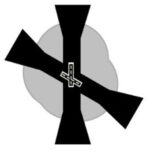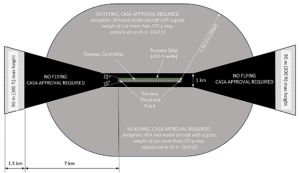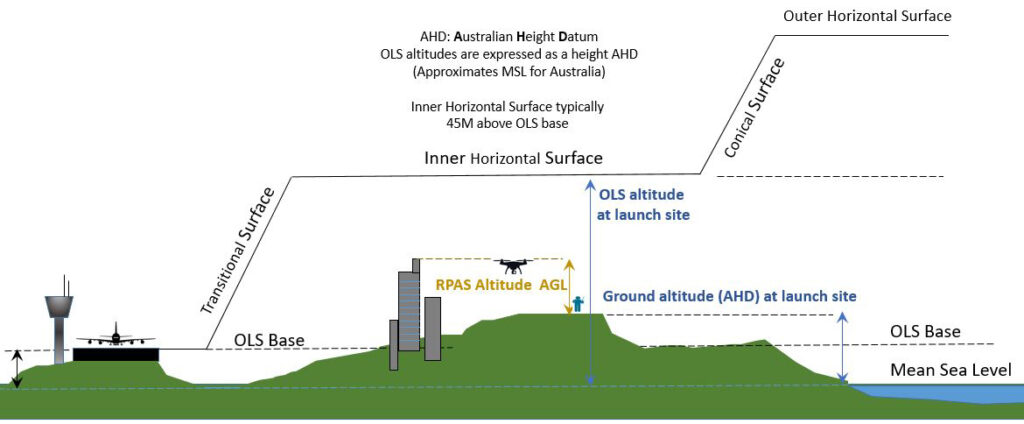Integrating RPAS into Australian airspace
Recognising the significant projected growth in the uncrewed industry and the introduction of new and emerging technologies, Airservices is committed to supporting the safe and efficient integration of Remotely Piloted Aircraft Systems (RPAS) into Australia’s airspace through a phased, inclusive approach.
This approach is centred around developing a suite of new cutting edge, digital and automated services for UAS operators to access airspace safely and efficiently and enabling the uncrewed industry to thrive. Launching in late May 2026, the Flight Information Management System (FIMS) will facilitate the exchange of important information to airspace users. Through selected Uncrewed Aircraft Systems (UAS) Services Suppliers (USS), eligible RPAS operators will gain access to automated authorisations across 28 civil controlled airports, tailored aeronautical data and strategic operational planning and coordination capabilities.
For further information visit Drones and Uncrewed Aircraft Systems Traffic Management - Airservices
Automated Airspace Authorisations Trail (AAAT)
In the lead up to our new services becoming available in late May 2026, we have collaborated with the Civil Aviation Safety Authority (CASA) to enable RPAS Certificate (ReOC) holders to apply for automated approvals for operations that fall within certain parameters through the Automated Airspace Authorisation trial.
CASA and Airservices have worked collaboratively to ensure the trial operates to the highest safety standards, enabling eligible drone operators to fly safely in restricted areas and within 3nm of selected controlled airports without disruption to regular air traffic.
Participating chief remote pilots can apply for authorisations through participating CASA-verified drone safety apps, with approvals granted in near real-time for flight requests submitted up to 30 days in advance. Flights are limited to daylight hours using registered drones under 25 kilograms. Approved operations do not require prior notification to air traffic control or the issuing of Notice to Airmen (or NOTAM), significantly reducing administrative burden.
Chief remote pilots can apply using a participating CASA-verified drone safety app for the following trial locations:
- Adelaide Airport (YPAD)
- Broome Airport (YBRM)
- Cairns Airport (YBCS)
- Canberra Airport (YSCB)
- Coffs Harbour Airport (YCFS)
- Essendon Airport (YMEN)
- Hobart Airport (YMHB)
- Melbourne Airport (YMML)
- Perth Airport (YPPH)
- Sydney Airport (YSSY)
- Sydney Harbour and surrounding areas (R405 A/B).
For further information about the trial including eligibility requirements, visit Automated airspace authorisations | Civil Aviation Safety Authority.
From late May 2026 automated airspace authorisations will be available for operations within 3nm of 28 civil controlled aerodromes through a USS connected to FIMS.
Airservices is committed to facilitating the successful entry of RPAS into controlled airspace in a staged process that will integrate with manned operations.
Operation in controlled airspace
RPAS with advanced equipment levels
In general terms, where the equipment levels and capability of the RPAS reflect those of conventionally piloted aircraft, ATC is responsible for providing a separation service to the RPAS in instances where an automated airspace authorisation is not available. Generally, the equipment and capability meets this threshold if:
- it is capable of presenting real time information from a certified navigation system;
- the pilot is able to maintain continuous two-way communications with ATC; and
- where applicable is equipped with certified surveillance equipment for the airspace in which it will operate.
Note: Portable or fixed installation Electronic Conspicuity (EC) devices (low power equipment able to transmit, and for some devices also receive ADS-B position messages), and Integrated Traffic Awareness Beacon System (TABS) devices (similar to an EC device, but also able to be detected by traffic collision avoidance system (TCAS)) may not be visible to ATC surveillance systems.
RPAS with basic equipment levels
Where the equipment levels and capability of RPAS do not reflect conventionally piloted aircraft, ATC responsibilities are determined by the location and height of the RPAS operation. RPAS operations in controlled airspace do not automatically trigger responsibilities for ATC.
No-Fly Zones around controlled aerodromes
The Manual of Standards (MOS) Part 101 depicts no-fly zones and approach and departure paths around controlled (and uncontrolled) aerodromes. The no-fly zone of a controlled aerodrome means any areas and airspace that are below 400 ft and:
-
- within 3 NM, in any direction, from the measurement point of any runway a controlled aerodrome; or
- within the approach and departure paths referred to in section 4.05, whether or not they extend beyond 3 NM, in any direction, from the measurement point of any runway of the controlled aerodrome. (MOS Part 101 Chapter 4).

 All applications for operations within the 'no-fly zones' of a controlled aerodrome or above 400FT within controlled airspace must be forwarded to the CASA RPAS Office in the first instance. Where automated airspace authorisations are available, these can be applied for via a CASA-verified Drone Safety App. Visit 'Flying drones/remotely piloted aircraft in Australia' (www.casa.gov.au) for more information.
All applications for operations within the 'no-fly zones' of a controlled aerodrome or above 400FT within controlled airspace must be forwarded to the CASA RPAS Office in the first instance. Where automated airspace authorisations are available, these can be applied for via a CASA-verified Drone Safety App. Visit 'Flying drones/remotely piloted aircraft in Australia' (www.casa.gov.au) for more information.
From late 2025 automated airspace authorisations will be available for operations within 3nm of 28 civil controlled aerodromes through a USS connected to FIMS.
Due to the nature of the operation and/or proximity to the aerodrome, some applications may be rejected or only approved subject to restrictions of, but not limited to, geographic lateral limits, vertical (altitude) limits, a specific time block and specific communication requirements.
Planning your flight
Applicants should review CASA requirements at https://www.casa.gov.au/drones before commencing an application. RPAS operators should also assess the extremities of their operating area to determine which portions of the no-fly zones may be infringed. Flights that are within 3NM but do not infringe the grey or black portions of the no-fly zones are more likely to be approved without further restriction. Controlled aerodromes are listed in the Designated Airspace Handbook (DAH).
Airservices segregate uncrewed operations from crewed operations within the 'no-fly zone' of a controlled aerodrome. Some of the segregation methods available include:
- Operations that are below the Obstacle Limitation Surface (OLS) of the aerodrome are more likely to be approved with minimal restriction.
- The RPAS is considered to be constrained below the OLS when:
- it is tethered below the OLS altitudes
- it is operating in close proximity to and below the height of a nearby obstacle that is below the OLS.
- for DJI RPAS, on board altimetry (following correction applied by Airservices based on flight time) indicates levels below the OLS.
- For non-DJI RPAS, on board altimetry from RTK/D-RTK or laser indicates operations are below the OLS.
- Where an operation penetrates the OLS there is an increased risk to conventionally piloted aircraft. These operations must be either:
- Shielded: An operation that is within 100m laterally of, and below an adjacent obstacle; or
- Segregated from conventionally piloted aircraft laterally or vertically.
Note: The following and diagrams are representative of the OLS for each aerodrome. For confirmation of accuracy and currency of the information, please contact the aerodrome operator.
| Adelaide | Albury | Alice Springs | Avalon |
| Bankstown | Brisbane OLS | Cairns | Camden |
| Coffs Harbour | Essendon | Jandakot | Karratha |
| Parafield | Rockhampton | Sydney | Tamworth 1 | Tamworth 2 |
Drone noise
New noise regulations apply to drones. The Department of Infrastructure, Transport, Regional Development, Communications, Sport and the Arts administer the drone noise regulations. Visit the Department’s website for more information about the changes.
Aircraft priorities
Aircraft priorities at controlled aerodromes are contained in the Aeronautical Information Publication Australia (AIP) ENR 10 Regulation of Flight – Assessment of Priorities.
RPAS surveillance
Increasingly, steps are being taken to monitor RPAS traffic in the vicinity of their aerodromes through passive surveillance systems. Currently Airservices has deployed passive surveillance at all controlled aerodromes in order to understand current levels of risk from RPAS. This system will be enhanced and expanded over time.
Future Airspace Management
Airspace is being transformed at a rapid rate by the emergence of new technologies that will allow products, services and aid to reach people and places faster.
See Drones and Uncrewed Aircraft Systems Traffic Management - Airservices
More information
See CASA https://www.casa.gov.au/drones for additional information including links to legislation, advisory circulars, guides to recreational and commercial flying, safety brochures, and forms.
See Australian Transport Safety Bureau (ATSB) for information on RPAS safety and occurrence reporting.
